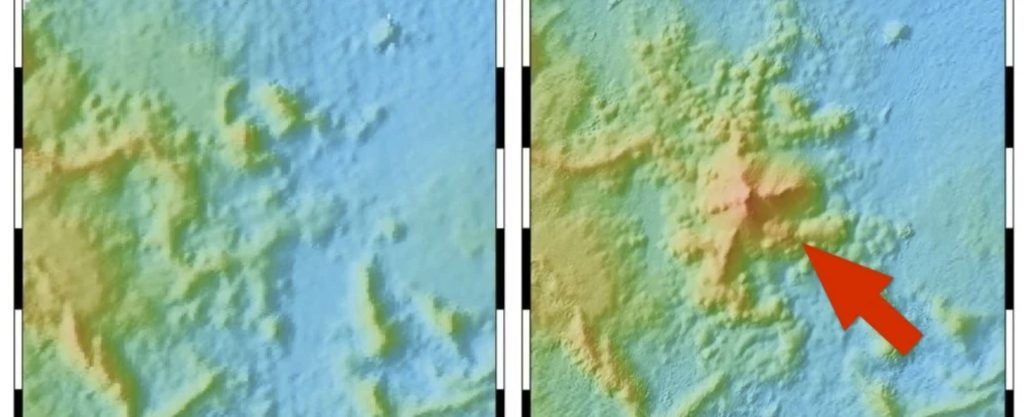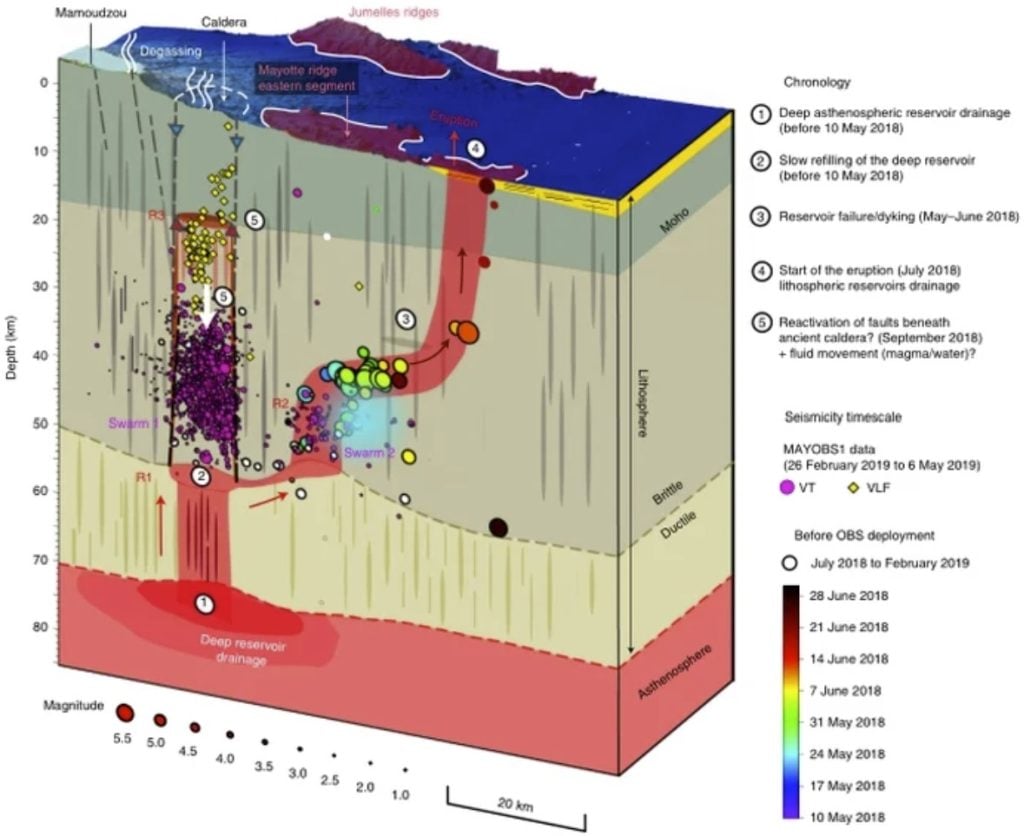
A huge seismic event that started in May of 2018 and was felt across the entire globe has officially given birth to a new underwater volcano.
Off the eastern coast of the island of Mayotte, a gigantic new feature rises 820 meters (2,690 feet) from the seafloor, a prominence that hadn’t been there prior to an earthquake that rocked the island in May 2018.
“This is the largest active submarine eruption ever documented,” the researchers wrote in their paper.
The new feature, thought to be part of a tectonic structure between the East African and Madagascar rifts, is helping scientists understand deep Earth processes about which we know relatively little.
The seismic rumbles of the ongoing event started on 10 May 2018. Just a few days later, on 15 May, a magnitude 5.8 quake struck, rocking the nearby island. Initially, scientists were perplexed; but it didn’t take long to figure out that a volcanic event had occurred, the likes of which had never been seen before.
The signals pointed to a location around 50 kilometers from the Eastern coast of Mayotte, a French territory and part of the volcanic Comoros archipelago sandwiched between the Eastern coast of Africa and the Northern tip of Madagascar.
So a number of French governmental institutions sent a research team to check it out; there, sure enough, was an undersea mountain that hadn’t been there before.
The scientists have now described their findings in a new paper.
The team began monitoring the region in February of 2019. They used a multibeam sonar to map an 8,600-square-kilometer area of seafloor. They also placed a network of seismometers on the seafloor, up to 3.5 kilometers deep, and combined this with seismic data from Mayotte.
Between 25 February and 6 May 2019, this network detected 17,000 seismic events, from a depth of around 20 to 50 kilometers below the ocean floor – a highly unusual finding, since most earthquakes are much shallower. An additional 84 events were also highly unusual, detected at very low frequencies.
Chronology of formation of the new underwater volcano near Mayotte
Armed with this data, the researchers were able to reconstruct how the formation of the new volcano may have occurred. It started, according to their findings, with a magma reservoir deep in the asthenosphere, the molten mantle layer located directly below Earth’s lithosphere.

Below the new volcano, tectonic processes may have caused damage to the lithosphere, resulting in dykes that drained magma from a reservoir up through the crust, producing swarms of earthquakes in the process. Eventually, this material made its way to the seafloor, where it erupted, producing 5 cubic kilometers of lava and building the new volcano.
The low-frequency events were likely generated by a shallower, fluid-filled cavity in the crust that could have been repeatedly excited by seismic strain on faults close to the cavity.
Largest underwater volcanic eruption ever near Mayotte
As of May 2019, the extruded volume of the new volcanic edifice is between 30 and 1,000 times larger than estimated for other deep-sea eruptions, making it the most significant undersea volcanic eruption ever recorded.
“The volumes and flux of emitted lava during the Mayotte magmatic event are comparable to those observed during eruptions at Earth’s largest hotspots,” the researchers wrote.
“Future scenarios could include a new caldera collapse, submarine eruptions on the upper slope or onshore eruptions. Large lava flows and cones on the upper slope and onshore Mayotte indicate that this has occurred in the past.
“Since the discovery of the new volcanic edifice, an observatory has been established to monitor activity in real time, and return cruises continue to follow the evolution of the eruption and edifices.”
Now subscribe to this blog to get more amazing news curated just for you right in your inbox on a daily basis (here an example of our new newsletter).
You can also follow us on Facebook and/ or Twitter. And, by the way you can also make a donation through Paypal. Thank you!
You should really subscribe to QFiles. You will get very interesting information about strange events around the world.













Approximately 26% of the adult Mayotte population, and five times as many women as men, report entering trance states in which they believe they are possessed by certain identifiable spirits (Djinns) who maintain stable and coherent identities from one possession to the next. https://en.wikipedia.org/wiki/Mayotte#Culture
And this is still nothing but a tickle to what’s coming our way thank God I live in the UK we have the most stable island in the world
UK isn’t the most stable continent or island in the world. Australia is, we have the hardest bedrock. It’s older than the UK landmass but just not explored as much till recent.
https://duckduckgo.com/?q=mayotte+%2B+Indian+ocean&t=h_&ia=images&iax=images
Pictures of the area. Looks beautiful. Another paradise. They have big green sea turtles and lagoons too.
https://humansarefree.com/2021/09/quarantine-facilities-for-americans.html
Isolation & Quarantine camps— Oven Camps. Jobs for sweepers and drivers available.